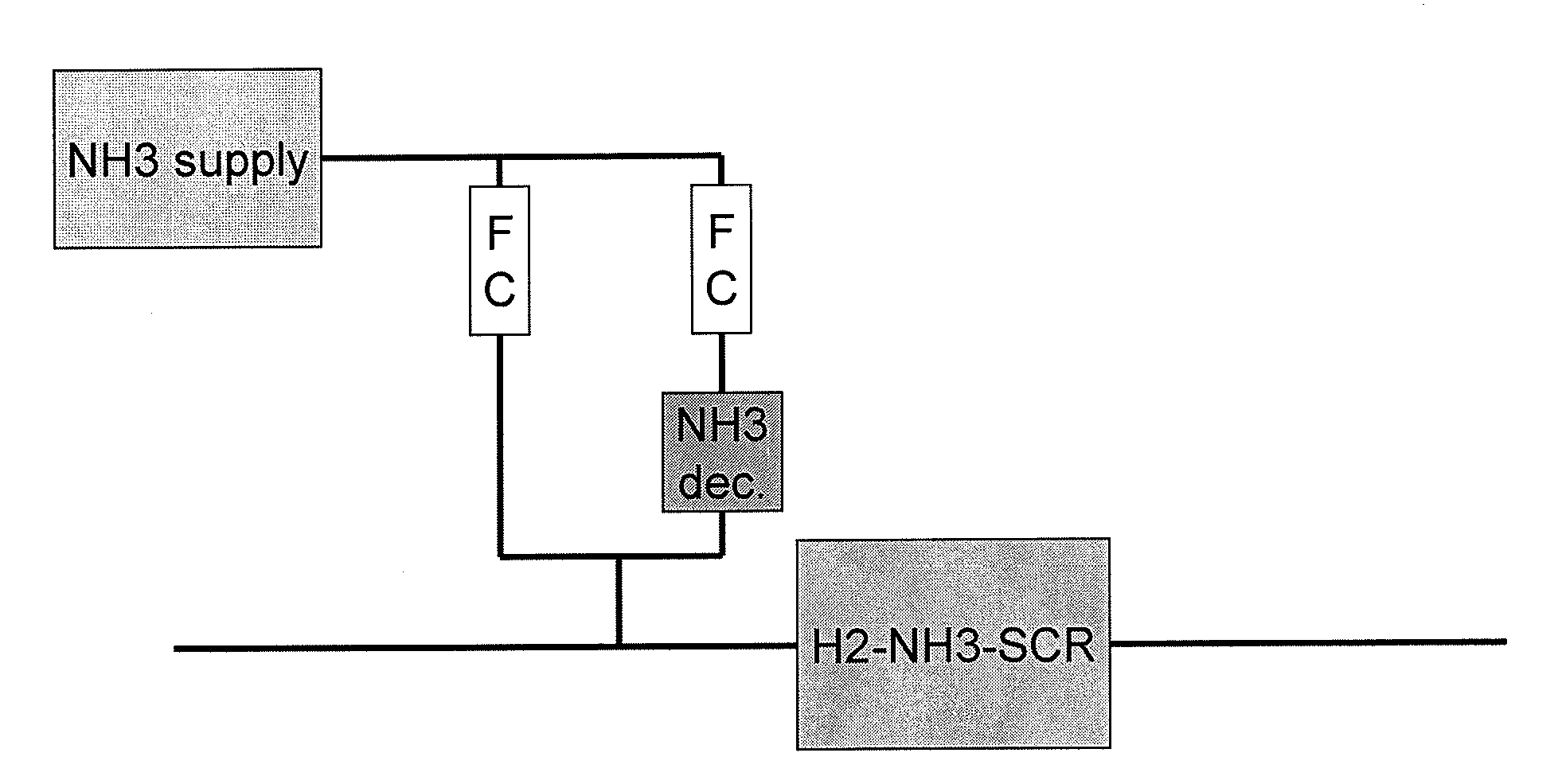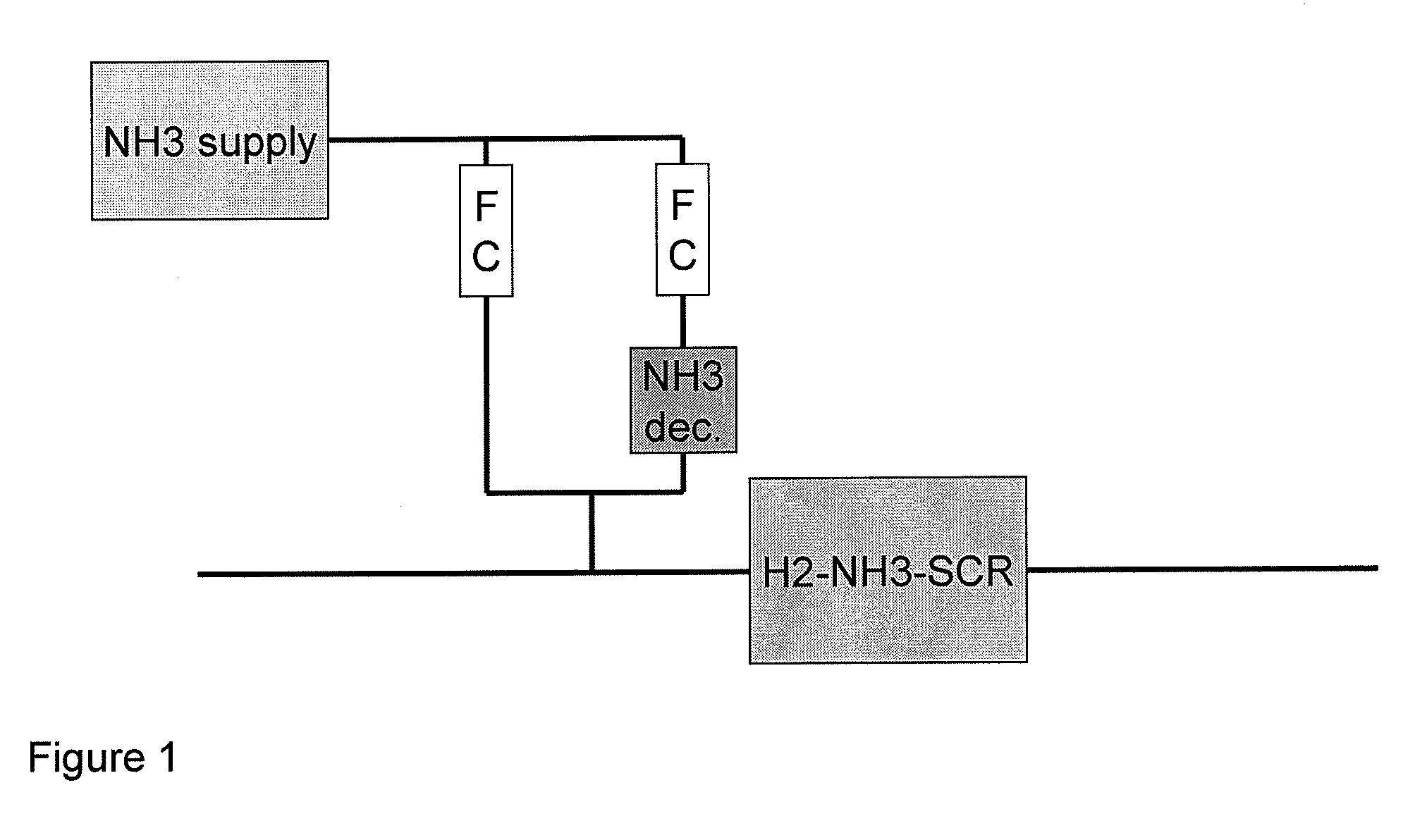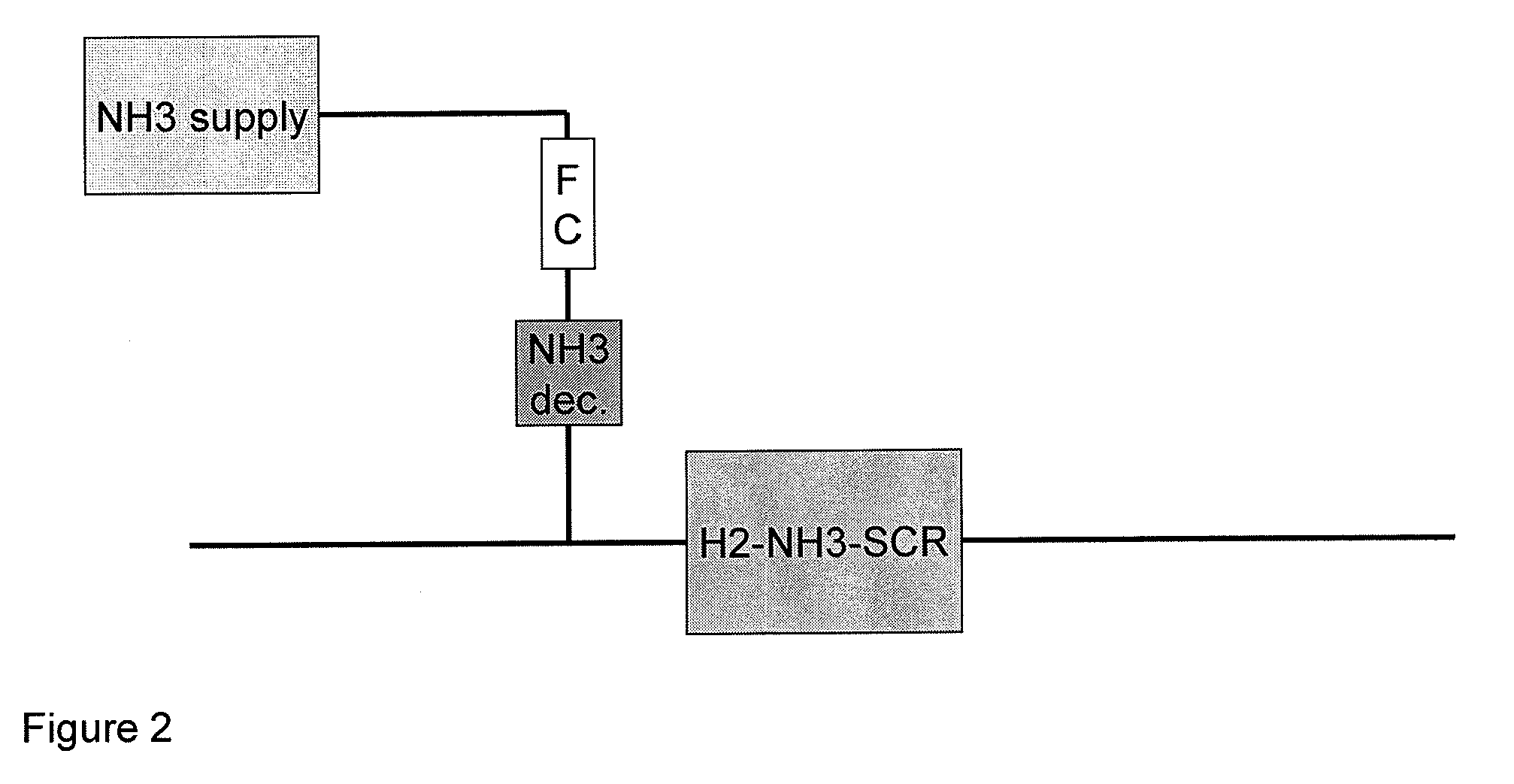Process and catalyst system for SCR of NOx
a catalyst system and catalyst technology, applied in the direction of metal/metal-oxide/metal-hydroxide catalysts, machines/engines, arsenic compounds, etc., can solve the problem of reducing the attractiveness of catalysts, reducing the efficiency of catalysts, etc. problem, to achieve the effect of stable performance and no tendency to deactivation
- Summary
- Abstract
- Description
- Claims
- Application Information
AI Technical Summary
Benefits of technology
Problems solved by technology
Method used
Image
Examples
example 1
Comparative
[0051]Experiments were conducted to evaluate the performance of 1% Ag—Al2O3 (1 wt %) in NH3-DeNOx upon changing H2 concentration from 100 to 1600 ppm. These experiments allow evaluation of the efficiency of overall NH3-DeNOx process with H2-coffeding in terms of the amount of H2 required for high NOx conversion.
[0052]The catalyst containing 1 wt % Ag / Al2O3 (SASOL 1, SBET=150 m2 / g) was prepared by incipient-wetness impregnation, where 3.0 g Al2O3 (SASOL N1) was loaded with 1 wt % Ag by incipient-wetness impregnation with a water solution of AgNO3 (2.2 ml) containing 0.014 g Ag / ml. The product was dried overnight at room temperature in air. The resulting material was calcined at 600° C. (4 h) in flowing air (−300 ml / min). The temperature was increased from room temperature to 600° C. at a rate of 0.5° C. / min.
[0053]The performance of 1% Ag—Al2O3 in NH3-DeNOx at different H2 concentrations is shown in FIG. 6, top part. Reaction conditions: GHSV=72 000 h−1, feed gas compositio...
example 2
Invention
[0057]The performance of layered Fe-beta-zeolite (commercial CP7124) and 1% Ag—Al2O3 (1 wt %) in NH3-DeNOx at different H2 concentrations was investigated. The amount of H2 added into the reaction mixture was changed from 100 ppm to 1600 ppm and the catalyst performance was evaluated at 100-550° C. Reaction conditions: Feed gas composition: 340 ppm NH3, 300 ppm NO, 100-1600 ppm H2, 7% O2, 4.5% H2O, 10% CO2 balance with N2. Overall flow rate: 500 ml / min. Catalyst load: 0.12 g Fe-beta-zeolite (front layer)+0.36 g 1% Ag / Al2O3 (downstream layer).
[0058]The layered catalyst consisted of a 0.12 g top layer (0.2 cm3) of Fe-beta-zeolite, fraction 0.4 to 1.0 mm and a 0.36 g bottom layer (0.5 cm3) of 1 wt % Ag / Al2O3 (SASOL 1).
[0059]The layered catalyst was prepared by incipient-wetness impregnation where 5.0 g Al2O3 (SASOL N1) was loaded with 1 wt % Ag by incipient-wetness impregnation with a water solution of AgNO3 (3.7 ml) containing 0.014 g Ag / ml. The product was dried overnight at...
example 3
[0065]The performance of simply mechanically mixing Fe-beta-zeolite with Ag / Al2O3 was compared with the dual bed Fe-beta-zeolite with Ag / Al2O3, in which there is spatial separation of both catalysts, with Fe-beta-zeolite as a front part of the catalyst.
[0066]Mechanically mixed catalyst system: 0.31 g (0.5 cm3) of 1 wt % Ag / Al2O3 (Boehmite)—prepared as described below—was mixed with 0.12 g (0.2 cm3) of Fe-beta-zeolite (CP 7124), thoroughly crushed to powder and pressed fraction of 0.4 to 1.0 mm. The 1 wt % Ag / Al2O3 (Boehmite) was prepared by incipient-wetness impregnation where 3.0 g of Boehmite was loaded with 1 wt % Ag by incipient-wetness impregnation with a water solution of AgNO3 (2.2 ml), containing 0.014 g Ag / ml. The product was dried overnight at room temperature in air and the resulting material was calcined at 600° C. (4 h) in flowing air (−300 ml / min). The temperature was increased from room temperature to 600° C. at a rate of 0.5° C. / min. The resulting catalyst compositio...
PUM
| Property | Measurement | Unit |
|---|---|---|
| temperatures | aaaaa | aaaaa |
| temperatures | aaaaa | aaaaa |
| temperatures | aaaaa | aaaaa |
Abstract
Description
Claims
Application Information
 Login to View More
Login to View More - R&D
- Intellectual Property
- Life Sciences
- Materials
- Tech Scout
- Unparalleled Data Quality
- Higher Quality Content
- 60% Fewer Hallucinations
Browse by: Latest US Patents, China's latest patents, Technical Efficacy Thesaurus, Application Domain, Technology Topic, Popular Technical Reports.
© 2025 PatSnap. All rights reserved.Legal|Privacy policy|Modern Slavery Act Transparency Statement|Sitemap|About US| Contact US: help@patsnap.com



